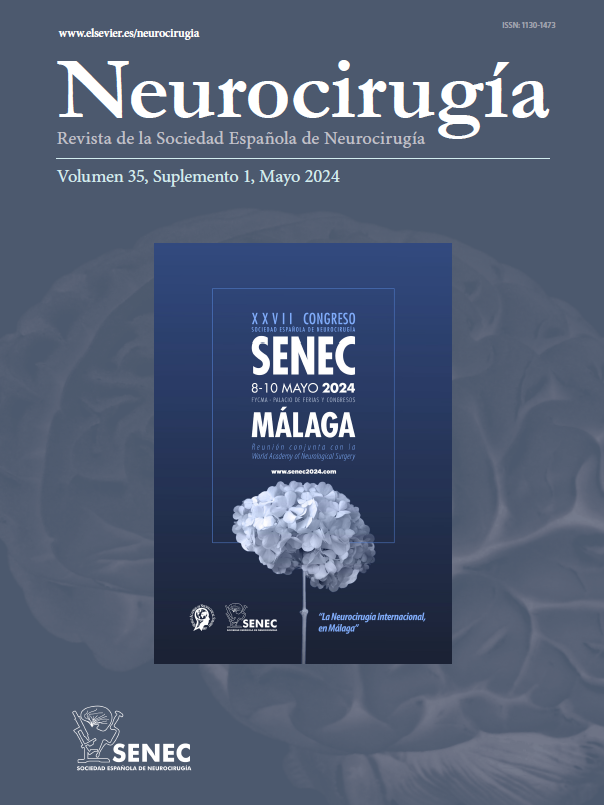La hemorragia subaracnoidea por aneurismas y malformaciones arteriovenosas es más frecuente en gestantes y puérperas. Analizamos el comportamiento de estas pacientes, su manejo y el efecto sobre ellas de nuestro Programa Nacional Materno Infantil.
Pacientes y métodosHubo 437 gestantes y 717 puérperas complicadas en el periodo de enero de 1996 a diciembre del 2005, 41 muertes maternas por todas las causas y 14 defunciones maternas indirectas. Fueron intervenidos 454 pacientes con aneurismas intracraneales y malformaciones arteriovenosas intracraneales. El obstetra evaluó las pacientes complicadas y el feto, para decidir la forma del parto. Las pacientes fueron manejadas precozmente por un colectivo médico interdisciplinario. Las lesiones vasculares fueron clipadas por métodos microneuroquirúrgicos. El manejo anestésico consideró los problemas inherentes a la gestación y al feto. No utilizamos métodos endovasculares. El seguimiento postoperatorio fue en la sala de Terapia Intensiva.
ResultadosHubo un total de ocho pacientes, entre gestantes y puérperas con hemorragia subaracnoidea por aneurismas o malformaciones arteriovenosas intracraneales. Seis tenían aneurismas intracraneales y dos malformaciones arteriovenosas. Realizamos siete intervenciones quirúrgicas, cinco en aneurismas y dos en malformaciones. Cuatro pacientes lograron una recuperación neurológica completa, dos una recuperación parcial y hubo dos fallecidas. Esta enfermedad constituyó el 14% de todas las causas de muertes maternas indirectas.
ConclusiónUn mejor diagnóstico clínico, los estudios por imágenes y el manejo interdisciplinario precoz que vincula la terapia intensiva, la atención obstétrica y los servicios de neurocirugía vascular determinan un incremento en el diagnóstico de estas lesiones que requieren un tratamiento microneuroquirúrgico o endovascular rápido y oportuno para evitar la muerte materna y el grave daño del feto.
Subarachnoid hemorrhage for aneurysms and arteriovenous malformations is most frequent during pregnancy and puerperium. We analyzed behavior and management of this patients and the effect on it of our Maternal Health Program.
Patients and methodsThere were 437 pregnancy and 717 puerperal complicated patients between january 1996 to december 2005, 41 maternal deaths of all causes and 14 indirect maternal deaths. There were operated on 454 patients with intracranial aneurysms and arteriovenous malformations in this period. Pregnant patients and fetus were evaluated to select mode of delivery. A specialized medical team managed precociously these patients. Vascular lesions were clipped by microsurgical methods. Anesthetic management considered pregnancy and fetal complexities. We did not use endovascular methods. Postoperative management was performed on intensive care unit.
ResultsThere were eight pregnant and puerperal patients with subarachnoid hemorrhage due to aneurysms and arteriovenous malformations. 2% of all patients were operated on by this cause. Six harboured intracranial aneurysms and two arteriovenous malformations. We performed seven surgical procedures, five for aneurysms and two for malformations. There was a delivery rate of 2.1 and seven normal newborn. Four patients achieved a complete neurological recovery, two a partial recovery and there were two deceaseds. This cause constituted 14% of all indirect maternal deaths.
ConclusionA precocious clinical diagnosis, neuroimaging studies and interdisciplinary management that involve intensive therapy, obstetric attention and neurovascular surgical treatment determined an increment in the diagnosis of these lesions that require opportune microsurgical or endovascular treatment to prevent maternal death and fetal damage.
Article

If it is the first time you have accessed you can obtain your credentials by contacting Elsevier Spain in suscripciones@elsevier.com or by calling our Customer Service at902 88 87 40 if you are calling from Spain or at +34 932 418 800 (from 9 to 18h., GMT + 1) if you are calling outside of Spain.
If you already have your login data, please click here .
If you have forgotten your password you can you can recover it by clicking here and selecting the option ¿I have forgotten my password¿.






